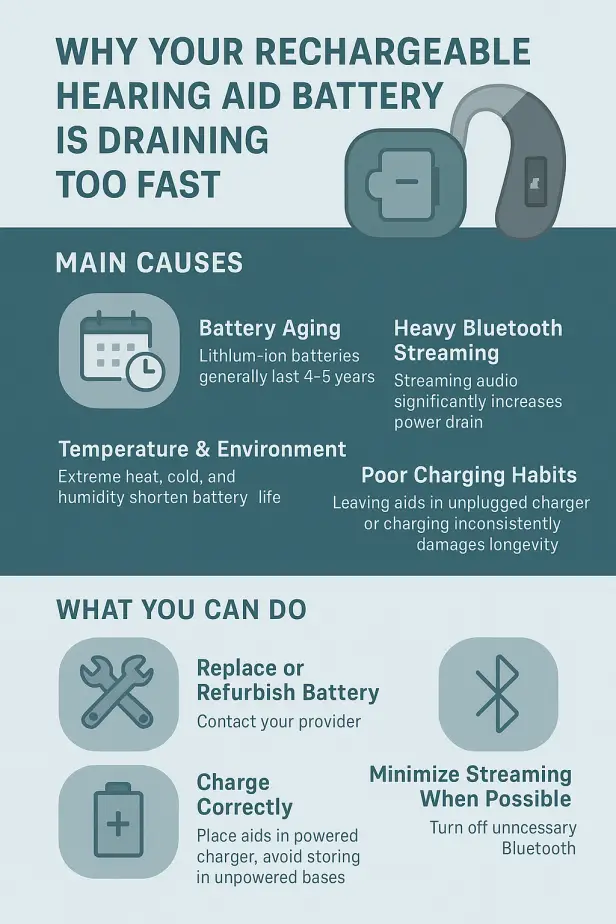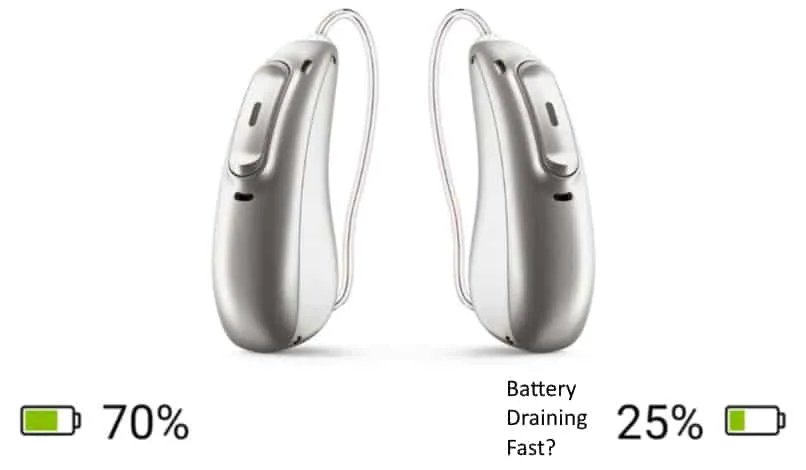
Modern rechargeable hearing aids are designed to last well over 24 hours on a single charge. If your battery is dying before the end of the day, it’s a sign something’s wrong — and it may be time for a repair or battery replacement. This guide explains why batteries drain faster over time, how to get them replaced, and how to make them last longer.
Why Rechargeable Hearing Aid Batteries Stop Lasting All Day
Almost all new hearing aids use lithium-ion batteries — the same technology used in smartphones and laptops. Over time, these batteries lose capacity, meaning they hold less charge. Typically, a lithium-ion hearing aid battery should last 4–5 years before a noticeable drop in performance. However, heavy streaming, extreme temperatures, or improper charging habits can shorten battery life.
When your hearing aid can no longer make it through a full day, it’s not something you can fix at home — the battery is sealed inside and must be replaced by the manufacturer or authorized service center.
Related: Why One Hearing Aid Battery Drains Faster Than the Other
How to Get a Rechargeable Hearing Aid Battery Replaced
If you bought your hearing aids from an audiologist or hearing instrument specialist, bring the device back to them. They’ll arrange to send it to the manufacturer for complete refurbishment — this typically includes replacing the battery, cleaning the device, and restoring it to like-new condition.
- Turnaround time: Usually 1–2 weeks
- Result: Essentially a “new” hearing aid with restored performance
If you’ve moved away from the original clinic, you can visit any licensed audiologist for assistance. You can find one locally via ZipHearing’s directory.
What If You Bought Hearing Aids Online?
Contact the manufacturer directly. Depending on the model, repair costs may be high enough that upgrading to a newer model could be more cost-effective — especially if your device is older than four years.
No DIY battery replacement is possible for brands like Phonak, Starkey, Resound, Signia, Rexton, Unitron, or Costco/Kirkland Signature due to FDA safety regulations. Lithium-ion cells are small enough to swallow, and only authorized repair facilities can safely replace them. The exception is some Oticon models, which may have serviceable batteries.
Battery Replacement Cost
- Under warranty: Free replacement (most warranties last 2 years, sometimes extended to 3)
- Out of warranty: Typically $150–$200 per device
Pro Tip: Schedule a refurbishment in the last month of your warranty. You’ll get fresh batteries and any worn parts replaced at no cost.
How to Check Your Warranty
There’s no public database to look up hearing aid warranty status. Your audiologist can contact the manufacturer with your serial number and confirm the expiration date.
Could the Charger Be the Problem?
Sometimes, the issue isn’t the battery — it’s the charger. Try swapping your hearing aids’ positions in the charger. If the same side consistently undercharges, you may need a new charger.
- Chargers are generally not covered under warranty
- Purchase replacements from your audiologist or on Amazon — ensure they match your hearing aid brand/model
How to Make Hearing Aid Batteries Last Longer
- Limit streaming — Phone calls, music, and TV streaming drain power fastest.
- Disable Bluetooth when not in use to reduce background battery drain.
- Charge nightly — Avoid letting the battery hit 0%, as deep discharges shorten lifespan.
- Store in moderate temperatures — Avoid leaving hearing aids in hot cars or cold garages.
Accessories like TV streamers or remote microphones are great for sound quality, but they do use extra power. Use them wisely if battery life is critical.
Typical Battery Life by Brand
For example, Phonak Paradise rechargeable hearing aids can last up to 30 hours on a full charge, or around 20 hours with 6 hours of streaming. Most full-time wearers average 12–14 hours daily, meaning your battery should remain above 50% for at least the first year.
Need More Help?
For a complete dive into keeping your hearing aids in top condition—covering cleaning, troubleshooting, repair tips, and routine care—check out our Complete Guide to Hearing Aid Maintenance & Repairs.
Explore the full maintenance and repair guide →
Related Questions
Are there hearing aids with replaceable rechargeable batteries? A few older models (2017–2019) used Z-Power silver-zinc batteries, which could be swapped by the user. These were discontinued due to reliability issues, but replacements are still available on Amazon.
When should I replace my hearing aids? Most people upgrade every 4–6 years due to improved technology and rising repair costs for older devices.

